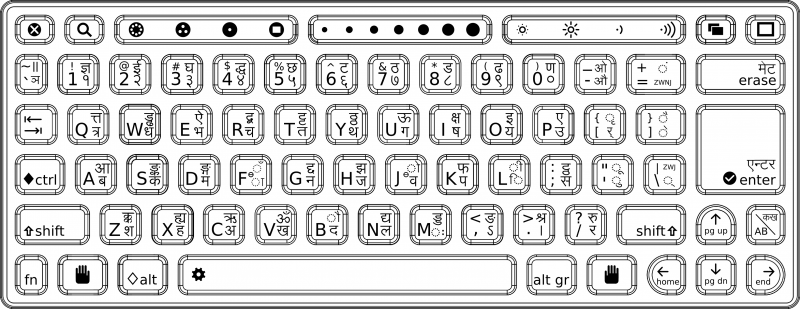OLPC Nepali Keyboard: Difference between revisions
| Line 10: | Line 10: | ||
Nepal will use SCIM rather than xkb for this keyboard layout |
Nepal will use SCIM rather than xkb for this keyboard layout |
||
[[ |
[[NP-MP-v4.pdf|Keyboard Image as PDF]] |
||
[[Category:Keyboard]] |
[[Category:Keyboard]] |
||
Revision as of 17:48, 5 January 2009
OLPC keyboard layouts
Instructions for setting up keyboard switching in Terminal are on the Customizing NAND images page. On bilingual XOs, the multiplication/division key is replaced with a keyboard switching key.
Changing the language of the keyboard is independent of changing the language currently displayed. The language currently displayed can be changed by using the Language section of the Sugar Control Panel.
Membrane keyboard layouts
English (US international); Spanish (Latin America); Portuguese (Brazilian); Amharic (Ethiopic); Arabic; Nigerian (Igbo, Hausa, Yoruba); French; Thai; Urdu; Cyrillic (Russian); Turkish; Nepali; Mongolian; Kazakh; Devanagari; Uzbek; Pashto; Dari; Armenian; Khmer; Pulaar; Italian; Kreyòl; German; Chinese (Simplified); OLPC AZERTY
Non-membrane keyboard layouts
Starting with the XO-1.5 HS ("High School") edition, the XO laptop has a traditional (non-membrane) keyboard available as an option: English (US International); Spanish (Latin America);
Blank Keyboard Artwork
Artwork defining the inner dimensions of the membrane keyboard is available here: keyboard-blank.svg
Nepali keyboard layout
This is the keyboard that will be used for Nepal's deployments in 2009.
Nepal will use SCIM rather than xkb for this keyboard layout Keyboard Image as PDF
